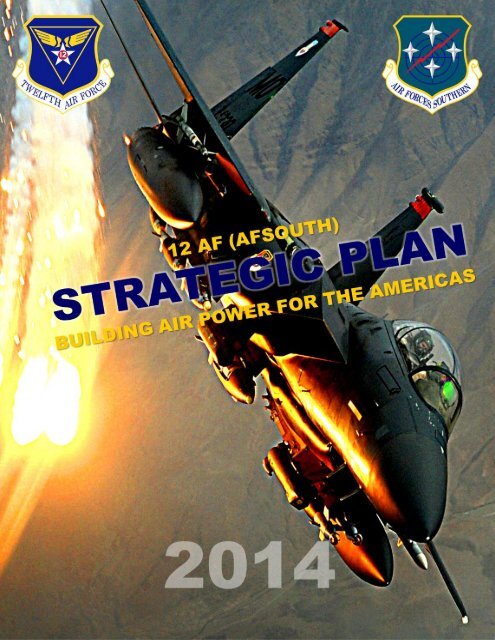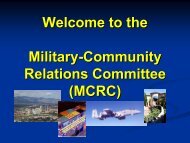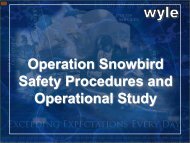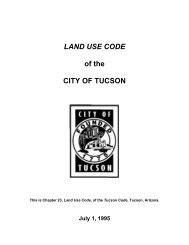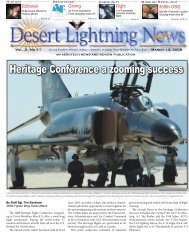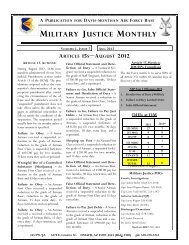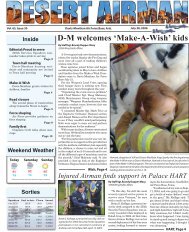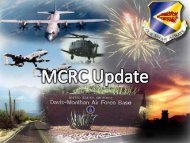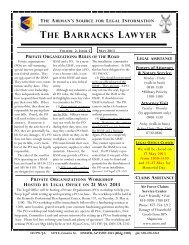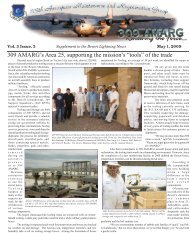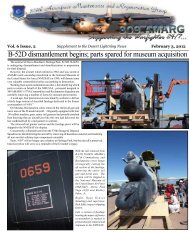Strategic Plan - Davis-Monthan Air Force Base
Strategic Plan - Davis-Monthan Air Force Base
Strategic Plan - Davis-Monthan Air Force Base
- No tags were found...
You also want an ePaper? Increase the reach of your titles
YUMPU automatically turns print PDFs into web optimized ePapers that Google loves.
2014 12 AF (AFSOUTH) STRATEGIC PLANTRUST, TRAINING, TEAMWORK 1
2014 12 AF (AFSOUTH) STRATEGIC PLANBuilding <strong>Air</strong> Power for the Americas
Foreword2014 12 AF (AFSOUTH) STRATEGIC PLANWe must continually look for innovative solutions to provide dominant combat airpower. Increased globalmission demands, decreased fiscal resources, and two decades of continuous combat operations have taughtus valuable lessons about getting the job done with limited resources. In order to continue to achieveresults, we must focus on unity of effort to reduce waste, overcome challenges, and produce a noticeablereturn on the investment of precious time and resources.The 2014 12 AF (AFSOUTH) <strong>Strategic</strong> <strong>Plan</strong> provides unity of effort and focus. It ties our objectives directly tothe President’s Unified Command <strong>Plan</strong>, US Southern Command’s Strategy 2022, and the 2012 <strong>Air</strong> CombatCommand <strong>Strategic</strong> <strong>Plan</strong>. Twelfth <strong>Air</strong> <strong>Force</strong> (<strong>Air</strong> <strong>Force</strong>s Southern) is charged with missions vital to ournation’s security. Every resource has to work towards the same goals. As such, our vision and mission forthe 12 AF (AFSOUTH) enterprise are:VisionProvide vigorous capabilities for global operations and deliver air dominance to USSOUTHCOM.MissionEnable combat-ready forces for rapid global employment; and receive, command and control, and employjoint air component assets to meet US strategic objectives in the USSOUTHCOM AOR, across the fullspectrum of operations.These ideals are straightforward but require deliberate efforts to execute. The 12 AF (AFSOUTH) enterprise isvast and diverse. Not only does 12 AF (AFSOUTH) manage the preponderance of <strong>Air</strong> <strong>Force</strong> combat assets,but as the air component to USSOUTHCOM, 12 AF (AFSOUTH) helps stabilize a dynamic regionintertwined with the United States geographically, economically, politically, and socially.This <strong>Strategic</strong> <strong>Plan</strong> illustrates our priorities. This <strong>Strategic</strong> <strong>Plan</strong> is not a stand-alone tool but is designed toaugment other assessments provided by assigned wings and organizations. It also highlights areas forimprovement and specifies focus areas that align with our desire to accomplish the mission while supporting<strong>Air</strong>men and their families.12 AF (AFSOUTH)’s greatest asset is our <strong>Air</strong>men…despite the challenges we face, these great <strong>Air</strong>men willcontinue to rise to the challenge of “Building <strong>Air</strong> Power for the Americas.”TOD D. WOLTERSLieutenant General, USAFCommanderTRUST, TEAMWORK, TRAINING
Table of Contents2014 12 AF (AFSOUTH) STRATEGIC PLANIntroduction .. . . . . . . . . . . . . . . . . . . . . . . . . . . . . . . . . . . . . . . . . . . . . . . . . . . 5Twelfth <strong>Air</strong> <strong>Force</strong> .. . . . . . . . . . . . . . . . . . . . . . . . . . . . . . . . . . . . . . . . . . . . . . . 5Twelfth <strong>Air</strong> <strong>Force</strong> Priorities and Focus Areas . . . . . . . . . . . . . . . . . . . . . . . . .6<strong>Air</strong> <strong>Force</strong>s Southern .. . . . . . . . . . . . . . . . . . . . . . . . . . . . . . . . . . . . . . . . . . . . . 9<strong>Air</strong> <strong>Force</strong>s Southern Priorities and Focus Areas ............................10Appendix A: Communications Flow within the NAF . . . . . . . . . . . . . . . . . . .14Appendix B: C-NAF, COMAFFOR, and the JFACC . . . . . . . . . . . . . . . . . . . . . .15Appendix C: Expanded 12 AF Objective Narratives . . . Published SeparatelyNOTE: Appendix C provides expanded narratives—the who, what, where, when, why, andhow—for all of the 12 AF objectives. In addition, it provides the 12 AF (AFSOUTH)minimum expectations and Best Seen Practices for a number of objectives related toCommanders’ Programs.4 Building <strong>Air</strong> Power for the Americas
2014 12 AF (AFSOUTH) STRATEGIC PLANIntroductionThe 2014 12 AF (AFSOUTH) <strong>Strategic</strong> <strong>Plan</strong> is a consolidated document, encompassing the entire ComponentNumbered <strong>Air</strong> <strong>Force</strong> (C-NAF) enterprise. It is written in two sections: Twelfth <strong>Air</strong> <strong>Force</strong> (12 AF) and <strong>Air</strong> <strong>Force</strong>sSouthern (AFSOUTH). The 12 AF section aligns with the 2012 <strong>Air</strong> Combat Command <strong>Strategic</strong> <strong>Plan</strong> and theAFSOUTH section aligns with USSOUTHCOM’s Strategy 2022. The implied tenets of good stewardship andproactive leadership apply equally to both. Each section consists of Commander’s priorities, specified focusareas, and objectives. Assigned units should strive to align their individual plans with this document andthose from which it is derived.Twelfth <strong>Air</strong> <strong>Force</strong> (12 AF)12 AF provides administrative oversight of its assigned wings and organizations and provides advocacy fortheir requirements. However, much of the traditional Operational Test and Evaluation (OT&E),programming, and daily operations of the assigned wings and organizations is managed directly by <strong>Air</strong>Combat Command (ACC). This communications flow is codified in ACC Pamphlet 38-158 and further detailedin Appendix A of this document.The 2014 12 AF (AFSOUTH) <strong>Strategic</strong> <strong>Plan</strong> will ensure we improve the combat capability of assigned forces,monitor and increase the resilience of our personnel, and increase efficiency across the 12 AF enterprise.2012 <strong>Air</strong> Combat Command <strong>Strategic</strong> <strong>Plan</strong>The 2014 12 AF (AFSOUTH) <strong>Strategic</strong> <strong>Plan</strong> aligns with, and flows from, the 2012 <strong>Air</strong> Combat Command<strong>Strategic</strong> <strong>Plan</strong>. The 2014 12 AF (AFSOUTH) <strong>Strategic</strong> <strong>Plan</strong> accounts for the fiscal realities facing the UnitedStates and highlights the need for a smaller, more capable force; relying on the solidarity and determinationof assigned <strong>Air</strong>men. The 2012 <strong>Air</strong> Combat Command <strong>Strategic</strong> <strong>Plan</strong> presents four priorities, and the 12 AF(AFSOUTH) <strong>Strategic</strong> <strong>Plan</strong> aligns with them where appropriate:Balance recapitalization and modernization within given resources.Develop, retain, and care for innovative, motivated, combat-focused <strong>Air</strong>men and their families.Focus organizations, training, and education to improve combat capability for current and futureoperations across the entire spectrum of conflict.Improve operational effectiveness and increase integration of <strong>Air</strong> <strong>Force</strong>, joint, allied, and coalitioncapabilities in advanced threat environments.TRUST, TRAINING, TEAMWORK 5
2014 12 AF (AFSOUTH) STRATEGIC PLAN12 AF Priority – Combat Capability and ReadinessThe 2012 <strong>Air</strong> Combat Command <strong>Strategic</strong> <strong>Plan</strong> states, “Excellence in combat airpower requires enhancingour ability to operate successfully in advanced threat environments.” Potential adversaries continue toacquire and develop anti-access and area denial (A2/AD) capabilities and strategies. We must take aggressivesteps to train in this environment. This effort begins with wing-level training, which is augmented bydistributed mission operations and advanced simulators, rehearsed during large force employment exercisessuch as RED FLAG, and validated through operational readiness inspections.Dealing with today’s fiscal reality requires a smaller, yet highly capable force. A smaller size creates the needfor strong partnerships. Strong partnerships not only include compatibility and interoperability of USAF andjoint systems, but also participation in a host of activities related to Building Partner Capacity (BPC). By“stacking” USAF and partner capacity within critical capability areas, we collectively provide dominantcombat airpower.12 AF will support “Combat Capability and Readiness” through the following focus areas:Focus: Increase number of counter A2/AD exercise objectivesObjective: Increase accomplished A2/AD exercise training objectives by 10% per yearFocus: Improve operational effectivenessObjective: Decrease discrepancies 25% for each inspected ‘readiness’ area from previous inspectionObjective: Maintain 100% compliance with COMACC’s Command Interest Items (CIIs)Objective: Maintain ART on-time reporting equal to or above USAF goalObjective: Decrease ART UTC deficiencies 5% per year compared to previous year with 100%postured/reportedObjective: Maintain 5/7 level upgrade training at 100% on-time completionObjective: Maintain 98% CDC pass rateFocus: Increase interoperability with all partnersObjective: Increase number of pre-trained, pre-identified ARC personnel used in AOC /AFFORexercisesObjective: Increase ARC / joint / inter-agencytraining events of any type (live, virtual,exercise) by 4 per yearIn addition, 12 AF will support Combat Capability andReadiness through the focus areas of the “Building PartnerCapacity/Capability” priority stated in the AFSOUTHsection of the 2014 12 AF (AFSOUTH) <strong>Strategic</strong> <strong>Plan</strong>.6 Building <strong>Air</strong> Power for the Americas
12 AF Priority – Foster Resilience2014 12 AF (AFSOUTH) STRATEGIC PLAN<strong>Air</strong>men are our most precious, sophisticated, and irreplaceableresource. Mission success depends on our ability to develop, retain,and care for innovative, combat-focused <strong>Air</strong>men and their families.Caring for them means we foster an environment that developsresilience, encourages innovation, and communicates eachindividual’s importance. As such, 12 AF will continue to promoteprograms that foster resilience and enhance development of all our<strong>Air</strong>men - to include the civilian force. Similarly, we will continue toimprove the care of our <strong>Air</strong>men’s families by bolstering familysupport systems at all levels. These programs will remain proactive and responsive, particularly for thefamilies of our deployed <strong>Air</strong>men.12 AF will support the “Foster Resilience” priority through the following focus areas:Focus: Increase sense of self-worth of assigned <strong>Air</strong>menObjective: Maintain Physical Fitness Assessment pass-rate equal to or above the USAF average.Objective: Maintain Physical Fitness Assessment “Excellent” ratings equal to or above the 12 AF goalof 70%.Objective: Maintain decoration approval prior to PCS rate at or above 90%.Objective: Decrease non-Individual Medical Readiness (non-IMR) rate by 2% a year with a goal ofmaking the non-IMR rate equal to the Duty Limiting Condition (DLC) rate.Objective: Maintain good order and discipline by resolving 80% of allegations of misconduct withinapplicable time standards.Focus: Ensure 12 AF (AFSOUTH) is a valued assignmentObjective: Maintain promotion rates equal to or above USAF average.Objective: Maintain on-time rates for performance evaluation at all levels at or above the USAFstandard.Focus: Strengthen the organizations that support <strong>Air</strong>men and familiesObjective: Maintain 100% unit-level contact with families of deployedmembers.Objective: Maintain 100% unit-level active Key Spouse programs.Objective: Maintain 100% unit-level contact and follow-through withsponsorship programs.Objective: Decrease Health and Wellness negative incidents 10%per year.Objective: Maintain unit-level First Sergeant manning equal to orabove the USAF average.Objective: Increase percentage of NCOs with completed degrees (prior to SNCO eligibility) 5% peryear.Objective: Maintain Club and MWR Fund Statistics within USAF goal of 7-15%.TRUST, TRAINING, TEAMWORK 7
2014 12 AF (AFSOUTH) STRATEGIC PLAN12 AF Priority – Increase EfficiencyToday’s leaders face difficult decisions that shape force projection and the options available to futurecommanders. The 2012 ACC <strong>Strategic</strong> <strong>Plan</strong> states, “the US National debt and corresponding fiscalrepercussions are a significant threat to our national security.”We will simply not enjoy the budget considerations of the past.Leadership in today’s environment requires innovativeapproaches to both resources and processes that maximize theprojection of airpower while minimizing costs. “Seekingopportunity out of austerity” means deliberately reviewingexisting business practices, developing innovative processes andtechniques, and taking calculated risks.12 AF will support the “Increase Efficiency” priority through the following focus areas:Focus: Balance Risk and Investment - Be good stewards of assigned assetsObjective: Ensure 100% of applicable Lessons Learned are incorporated into subsequent exerciseswith a goal of zero repeats.Focus: Decrease waste at all levels from previous year without impacting missionObjective: Reduce number of ground and flight Class C mishaps by 5% per year.Objective: Reduce energy footprint per gross square foot by 30% of FY03 levels by 2015 and 37.5%by FY20 IAW the <strong>Air</strong> <strong>Force</strong> Implementation <strong>Plan</strong> of the FY11 DoD <strong>Strategic</strong>Sustainability Performance <strong>Plan</strong>.8 Building <strong>Air</strong> Power for the Americas
<strong>Air</strong> <strong>Force</strong>s Southern (AFSOUTH)2014 12 AF (AFSOUTH) STRATEGIC PLANAFSOUTH is the air component to the Commander, US Southern Command (USSOUTHCOM). TheCommander, 12 AF (AFSOUTH) is designated as both Commander, <strong>Air</strong> <strong>Force</strong> <strong>Force</strong>s (COMAFFOR) and Joint<strong>Force</strong> <strong>Air</strong> Component Commander (JFACC). See Appendix B for a further discussion of these roles.USSOUTHCOM Strategy 2022 and the Unified Command <strong>Plan</strong>The responsibilities listed in the President’s Unified Command <strong>Plan</strong> inform the strategic objectives ofUSSOUTHCOM’s Strategy 2022. USSOUTHCOM’s objectives rely upon strong partner nations along with jointand interagency cooperation. AFSOUTH priorities flow from these objectives and are aligned with bothcurrent operations and existing theater cooperation plans.As the combatant command air component, a responsibility of AFSOUTH is to support the defense of theUnited States and its interests by providing air, space, and cyberspace effects in the USSOUTHCOM area ofoperations (AOR). Barring declared hostilities, AFSOUTH helps achieve USSOUTHCOM theater military endstates by supporting joint and interagency efforts of detainee operations, counter transnational organizedcrime, build partner nation security capacity, and plan for contingencies. The unpredictable nature ofcriminal and terrorist organizations, natural and man-made disasters, and their potential for devastatingimpact demand AFSOUTH is prepared to respond across a wide spectrum of operations. To accomplish thissupport, AFSOUTH must efficiently identify, exploit, and focus all air component competencies by deliveringair-centric effects in support of USSOUTHCOM and by building partner nation air-centric capacity/capability.TRUST, TRAINING, TEAMWORK 9
2014 12 AF (AFSOUTH) STRATEGIC PLANAFSOUTH Priority – Deliver <strong>Air</strong>-Centric Effects in Support ofUSSOUTHCOMThe July 2011 White House CTOC Strategy and the USSOUTHCOM Theater Cooperation <strong>Plan</strong> (TCP) state thattransnational organized crime directly challenges US domestic and international security. Not only are thesouthern approaches to the United States held at-risk by increasing transnational criminal networks and illicittrafficking activities, but the domestic social, economic, and political impacts have made the proliferation oftransnational organized crime a US security concern.To support counter transnational organized crime (CTOC) and contingency operations, AFSOUTH will deliverair-centric effects in support of USSOUTHCOM. Delivery of air-centric effects is accomplished byconcentrating efforts along the following focus areas:Focus: Command and control (C2) of joint air assetsFocus: ISR processing, exploitation, and disseminationAchievement of these focus areas is part of the day-to-day business of the 612th <strong>Air</strong> and Space OperationsCenter (612 AOC). 612 AOC’s five divisions engage in several planning cycles wherein they receive guidance,direction, and requirements, then coordinate, develop, and disseminate joint air operations plans, monitorand control mission execution, and assess, interpret, and disseminate the results. The most widely known ofthese cycles is the <strong>Air</strong> Tasking Order (ATO) process.Assessment of the success of each mission is reported through anoperational feedback summary for each mission executed insupport of USSOUTHCOM. Success is presented through fourmeasures: (1) the operation itself, i.e., what happened, along withany impacts to the mission;(2) operational highlights, i.e., specificmission success as reported from the requesting agency;(3) challenges, outlook, and issues related to the operations, andfinally; (4) a “map” presenting the percentages of ‘targets’ taskedversus requested, i.e., sites, go-fast boats, etc., targeted forcollection. This information is presented for each variant ofplatforms used in support ofUSSOUTHCOM missions.10 Building <strong>Air</strong> Power for the Americas
2014 12 AF (AFSOUTH) STRATEGIC PLANAFSOUTH Priority – Build Partner Nation <strong>Air</strong>-CentricCapacity/CapabilityThe next priority is to facilitate partnernations in developing, maintaining, andemploying air-centric capability in order tocultivate our partners’ aviation enterprise. 1No country can single-handedly meet or solveall the challenges within the USSOUTHCOMAOR and no single service component canprovide the solution on its own. A long-termand deliberate strategy and an executableplan derived from that strategy demonstratean enduring commitment and drives greatersuccess. A solid commitment to thesecombined effects will solidify the UnitedStates as the enduring partner of choice.Deliberate engagements toward collective ends overcome collective challenges. Engagements also formeffective habits of cooperation. Both AFSOUTH strategy and the concept of operations maximize theintegration of air-centric capacity/capability into both partner nation and USSOUTHCOM efforts. AFSOUTHwill cultivate regional interoperability and increase shared regional domain awareness. In so doing,AFSOUTH will directly and indirectly increase partner nations’ abilities to control their sovereign territory,thereby supporting USSOUTHCOM strategic objectives. AFSOUTH will support the building of partnernations’ air-centric capacity/capability and aviation enterprise development along the following focus areas:Focus: Command and Control (C2)Focus: Operational MobilityFocus: Intelligence, Surveillance, and Reconnaissance (ISR)Focus: <strong>Air</strong> Domain AwarenessFocus: Sustained Mission SupportThe AFSOUTH Campaign Support <strong>Plan</strong> (CSP) details the objectives and measures developed to achieveprogress in building a partner nation’s air-centric capacity/capability along the above focus areas. 2 The planestablishes yearly objectives and measures of success for each partner nation as assigned to AFSOUTH by theUSSOUTHCOM TCP. For the sake of brevity, these objectives and measures are not included in this <strong>Strategic</strong><strong>Plan</strong>. Although the objectives and measures are not repeated here, the following paragraphs outline the BPCmeasure of success process.1.Aviation Enterprise Development (AED) not only directly supports USSOUTHCOM objectives, but is also part of a larger CSAF vision to shape the Global Domain bycultivating capable partners. Aviation Enterprise Development is defined as “the plans, programs, and activities undertaken to develop the system of systemsnecessary for a nation to optimize employment of national aviation resources. The total aviation resource capacity and capability of a nation is defined by the sumtotal of all air domain resources including humans, aircraft, processes and infrastructure in both the civilian and military/security sectors.” [2011 USAF GlobalPartnership Strategy]2.The Campaign Support <strong>Plan</strong> refers to focus areas as lines of effort. The term focus area is used here to remain consistent with the 12 AF (AFSOUTH) <strong>Strategic</strong><strong>Plan</strong>.TRUST, TRAINING, TEAMWORK 11
2014 12 AF (AFSOUTH) STRATEGIC PLANThe overall measure of success is to realize a yearly, positive change in a partner nation’s air-centriccapacity/capability along the preceding focus areas. Success is measured separately for each partner nationand is determined through a deliberate, holistic analytic process. That process is summarized in thefollowing paragraphs.Three levels of success demonstrate achievement of objectives.First, individual event success is captured explicitly. That success ismeasured through the accomplishment of tactical objectives. Forexample, one metric is the measure of the number of partner nationpersonnel trained (e.g., aircraft maintenance, fuel operations, andintelligence exploitation and dissemination personnel trained).Coupled with other similar metrics, event success is demonstrated atthe tactical level.The second level of success is focused on the partner nation’s capacity increase; a measure of that partnernation’s air-centric performance potential. For example, one metric is the measure of the number of aircrafta partner nation unit can launch in a given timeframe as compared to that unit’s previous launch rate. Thismetric lies at the heart of the AFSOUTH priority, build partner nation air-centric capacity/capability, as itdemonstrates a positive (or negative) change in a unit’s air-centric capability over time.Finally, the third level of success is focused on the partner nation conducting air-centric operations directlyin support of CTOC or contingency operations, whether supporting USSOUTHCOM theater campaign plansand/or local/regional partner nation security objectives. The purpose of this level of assessment is tomeasure the effectiveness of a partner nation’s air-centric capacity/capability. For example, one metric is themeasure of the number of times a partner nation launched an interceptor to visually identify an illicit aircraft.The third level of successdemonstrates the ‘so what’ ofAFSOUTH’s efforts to build a partnernation’s air-centric capacity/capability.By measuring success of tacticalevents (task accomplishment),measuring a partner nation’sair-centric capacity/capability increase(a measure of performance of thatpartner nation), and finally measuringthe partner nation’s operationalactivities supporting CTOC or local/regional objectives (a measure ofeffectiveness), AFSOUTH willdemonstrate the level of successachieved in building a partner nation’sair-centric capacity/capability alongthe focus areas.12 Building <strong>Air</strong> Power for the Americas
2014 12 AF (AFSOUTH) STRATEGIC PLANAppendix A: Communications Flow within the NAFThe foundation of good teamwork both in the air and on the ground relies upon clear and concisecommunications. While 12 AF (AFSOUTH) follows the skip echelon guidance provided in <strong>Air</strong> <strong>Force</strong> Instruction38-101, <strong>Air</strong> <strong>Force</strong> Organization, and in ACC Pamphlet 38-158, Headquarters <strong>Air</strong> Combat Command SkipEchelon Support to Field Units, good communications goes beyond that. We rely upon common sense at alllevels to ensure comm flow both up and down the chain of command takes place to keep the mission movingforward. This appendix provides amplifying guidance based on 12 AF (AFSOUTH) Commander’s desire toadvise, advocate, and provide top cover for wings.Amplifying guidance for 12 AF (AFSOUTH) execution of skip echelon is presented along three themes:Call the Boss, Prior Coordination, and Concurrent Notification.Call the BossFirst, and foremost, call the 12 AF (AFSOUTH) Commander if:- Something will appear in the headlines.- A squadron or group leadership change in your wing is required.- Your ability to accomplish the mission is in question.- People were injured or ‘big ticket’ items were broken.Prior CoordinationThe philosophy behind prior coordination is to advise the 12 AF (AFSOUTH)Commander on issues requiring advocacy and to allow the 12 AF (AFSOUTH)staff time to review and improve inputs.Coordinate the following through the Directorate of Manpower, Personneland Services (A1):- Nominations for squadron command, SDE selection, and command selection board.- Hiring procedures exceptions to policy.- Non-aircraft deployment planning.- Promotion, retention recommendation, and selective early retirement board forms.- Squadron commander, director of operations, and wing chief of safety (hiring authority andwaivers).- Special programs and awards.TRUST, TRAINING, TEAMWORK 13
Appendix A: Continued2014 12 AF (AFSOUTH) STRATEGIC PLANCoordinate the following through the Directorate of Operations (A3):- <strong>Plan</strong>ned loss of runway.- Reclamas.- Reporting of C3 or worse in SORTS.Coordinate through the Directorate of Logistics (A4) the following:- Inspection and re-inspection preparations.- Significant trends in Maintenance Performance Indicators.Coordinate through the Directorate of Communications (A6) the following:- Inspections.- Network Operations directives.Coordinate through <strong>Strategic</strong> Requirements and Programming (A8) the following:- New POM initiatives.Coordinate through the Chief of <strong>Force</strong> Protection (FP) the following:- Assistance for higher headquarters inspections.- Combat arms shortfalls impacting training.- Funding shortfall negatively affecting installation integrated defense.Concurrent NotificationThe philosophy behind concurrent coordination is to advise the 12 AF (AFSOUTH) Commander when he/she may bequeried, and to allow the 12 AF (AFSOUTH) staff to prepare the Commander.Coordinate the following through the Directorate of Manpower, Personnel and Services (A1):- <strong>Air</strong>craft-related deployment requirements planning.Coordinate the following through the Directorate of Logistics (A4):- Quarterly fleet reviews.Coordinate the following through the Directorate of Communications (A6):- Classified message incidents.- Service outages.Coordinate the following through <strong>Strategic</strong> Requirements andProgramming (A8):- Loss of PE Coded Programs and POM initiatives.- Award of PE Coded Programs and POM initiatives.Coordinate the following through the Judge Advocate (JA):- Environmental litigation, sanctions, or enforcement that might impact base operations- Civilian labor disputes or litigation that might impact base operations.Coordinate the following through the Chief of <strong>Force</strong> Protection (FP):- <strong>Plan</strong>ned/actual protests adversely affecting base personnel/mission.- Active shooter, hostage scenario, and real-world local <strong>Force</strong> Protection Condition changes.- Theft of security force weapons/ammo/etc.14 Building <strong>Air</strong> Power for the Americas
2014 12 AF (AFSOUTH) STRATEGIC PLANAPPENDIX B: AFSOUTH and the Component Numbered <strong>Air</strong><strong>Force</strong> (CNAF) DefinedUnder the Joint <strong>Force</strong>s concept, all <strong>Air</strong>, Land, Maritime and Special Operations forces operate as equalmembers of a joint team, commanded by the Unified Combatant Commander (COCOM). The COMAFFORprovides support of USAF assets through the A-Staff (A1 thru A9). When common functions exist acrossservice lines, the COCOM may also designate a functional component commander. All air forces assigned(including USN, USMC, USA assets) are then operationally controlled by the JFACC if designated by theCOCOM. The JFACC commands and controls the assigned air forces through the AOC. The JFACC directlysupports the COCOM and the President.The CNAF consists of the both the AOC and the AFFOR staff. It is the critical link that allows the COMAFFORto orchestrate air, space, and information operations against an adversary or to bring humanitarian aid to thescene of a natural disaster anywhere in the world. Though the COMAFFOR and JFACC are two separatecommands, the COMAFFOR is normally designated as the JFACC. The JFACC achieves centralized commandand control of assigned air forces through the AOC Weapon System.The AOC consists of five divisions: the Strategy Division (SRD), Combat <strong>Plan</strong>s Division (CPD), CombatOperations Division (COD), Intelligence, Surveillance and Reconnaissance Division (IRD) and the <strong>Air</strong> MobilityDivision (AMD). The AOC also has multiple specialty teams and support teams, to include a CommunicationsSupport Team.The AFFOR consists of the Commander’s support and personal staff, and the A-Staff (A1 thru A-9). While theAOC commands and controls the warfighting execution, the AFFOR provides the support to those <strong>Air</strong>men.The AFFOR is defined as the USAF service support mechanism that establishes bases and sustains thewarfighters. It is the global support capability that enables the warfighter to deploy anywhere on the globeand stay for as long as the COCOM requires. The AFFOR also shapes the COCOM’s peacetime andengagement activities within the AOR. In the SOUTHCOM AOR, the AFFOR staff and augmentation willusually plan and execute humanitarian and natural disaster responses.TRUST, TRAINING, TEAMWORK 15


